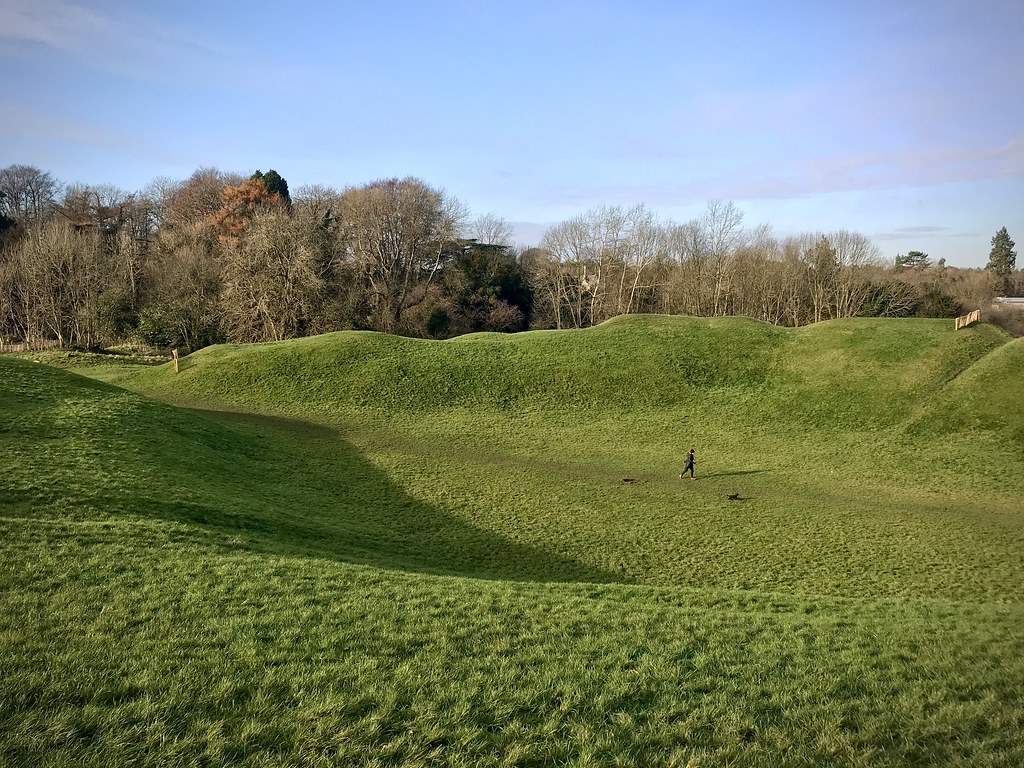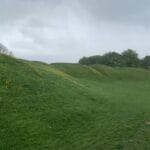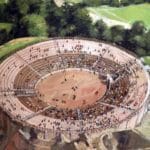Journey back in time to Roman Britain and discover the Cirencester Amphitheatre, a remarkable testament to Roman engineering and social life nestled in the heart of the Cotswolds. This colossal structure stands as one of Britain’s largest and best-preserved Roman amphitheatres, offering a captivating glimpse into the vibrant past of Corinium Dobunnorum, the bustling Roman town that once stood here.
Unearthing the Secrets of Cirencester’s Amphitheatre
This impressive amphitheatre, located just outside the walls of what was once Corinium Dobunnorum (now Cirencester), provides a fascinating window into Roman life in Britain. Its near-perfect oval shape, approximately 150 feet by 135 feet, was predominantly created using earthworks—a monumental undertaking that speaks volumes about Roman engineering and the scale of entertainment it was designed to host. Imagine the roar of the crowd as gladiators clashed and exotic animals roamed the arena!
Roman Engineering Marvel: Building the Amphitheatre
Constructed around the early 2nd century AD, the amphitheatre’s design reflects Roman engineering mastery. The use of earthworks, likely supplemented with stone, was a common Roman technique, showcasing their ability to adapt building methods to available resources. The tiered seating arrangement, capable of accommodating thousands of spectators, was carefully designed to maximize viewing angles while minimizing obstructions. Some experts believe the amphitheatre’s capacity likely reached 8,000 people, indicating its importance as a central hub for public life. There is continued debate on exactly how the structure was built, with ongoing research potentially unveiling fresh insights into Roman building practices.
Beyond Entertainment: The Amphitheatre’s Evolving Role
While undoubtedly used for spectacular gladiatorial contests, wild animal hunts, and other public events, the amphitheatre’s story is more nuanced. Some historians suggest it may have been repurposed as a temporary fort at some point. This adaptability reflects the practical and strategic thinking of the Romans, who were adept at modifying existing structures to meet changing needs. The exact timing and circumstances of its abandonment remain a mystery, with ongoing archaeological research slowly piecing together the details of this period. It’s a testament to the layers of history that the site continues to reveal.
Archaeological Discoveries: Unearthing Roman Life
Excavations at the amphitheatre have unearthed a wealth of artifacts that provide invaluable insights into daily life in Roman Corinium. Archaeologists have uncovered a variety of objects, from pottery shards and tools to personal belongings, offering a tangible connection to the people who lived and worked near this grand arena. These finds shed light not only on construction techniques but also on the daily routines, social structures, and trading networks of the time. Ongoing research promises to further illuminate the vibrant tapestry of Roman life in this important settlement.
Preservation and Access: Protecting History for Future Generations
Today, English Heritage plays a vital role in preserving the Cirencester Amphitheatre, ensuring its accessibility to visitors and protecting this critical piece of Roman Britain’s heritage. The Friends of the Amphitheatre (AQIVA) also actively contribute to its upkeep and interpretation. Their combined efforts ensure that this impressive site remains open for public exploration, offering a chance to connect with over 2,000 years of history. Their dedication is integral to preserving this important historical site for future generations of scholars and the public alike.
Visiting the Cirencester Amphitheatre: Your Journey Through Time
A visit to the Cirencester Amphitheatre offers a unique opportunity to journey back in time. Though much of the original structure has vanished over time, what remains—primarily the earthworks—still powerfully evokes the grandeur of this ancient arena. Walk the outlines of the seating tiers, envision the crowds, and imagine the excitement of a Roman public spectacle.
Practical Information:
| Feature | Details |
|---|---|
| Opening Times | Check the English Heritage website [https://www.lolaapp.com/english-heritage-link] for the latest info. |
| Accessibility | The site is reasonably accessible; check online [https://www.lolaapp.com/accessibility-link] for details. |
| Directions | Follow signs from Cirencester town centre. |
| Parking | Ample parking is available nearby. |
| Nearby Attractions | Don’t miss the Corinium Museum [https://www.lolaapp.com/corinium-museum-link] for more about Roman Cirencester! |
A Timeline of the Amphitheatre:
| Period | Event | Significance |
|---|---|---|
| Early 2nd Century AD | Construction of the Cirencester Amphitheatre | Became a vital entertainment venue in Corinium. |
| 2nd-4th Centuries AD | Used for public games and spectacles | Showcased Roman power and leisure; a key part of Roman life. |
| Likely 4th/5th Century AD | Possible conversion to a temporary fort (this is debated) | Highlights the adaptability of Roman structures during change. |
| Sometime after the 4th Century AD | Gradual abandonment of the Amphitheatre | Marks the end of a significant period of Roman activity in the area. |
| 18th/19th Centuries AD | Rediscovery and initial excavations | Brought the Amphitheatre to the attention of the wider world. |
| 1973 | English Heritage takes on guardianship | Ensures the long-term protection of the site. |
| Present Day | Ongoing preservation and public access | Remains a significant historical site and tourist attraction. |
The story of the Cirencester Amphitheatre is far from over. Ongoing research and archaeological investigation continue to unveil new details, refining our understanding of this remarkable site and its place within the broader narrative of Roman Britain.
(Remember to replace the bracketed placeholders [https://www.lolaapp.com/…] with actual links.)
- Discover Long Black Pepper: Flavor & Health Benefits - April 25, 2025
- Shocking Twists: The Grownup Review: Unreliable Narration - April 25, 2025
- A Quiet Place Book vs Movie: A Deep Dive - April 25, 2025
















